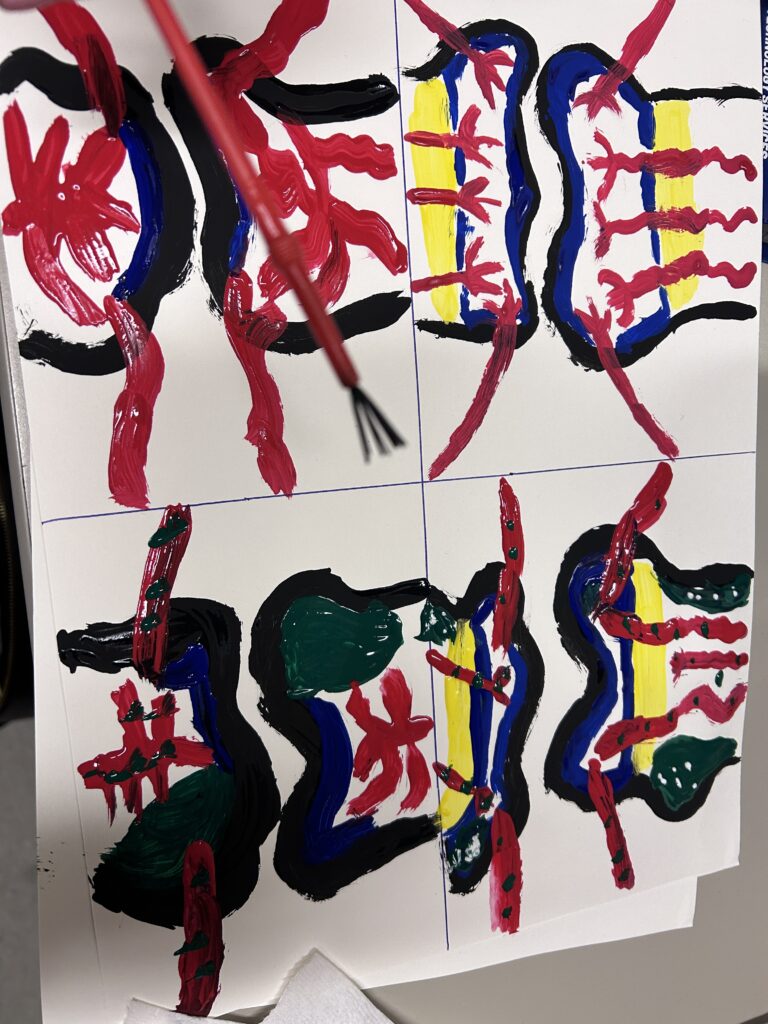

Two photos above are the process of my art and the cover photo is the finished painting of different types and states of bone relating to bone infection (osteomyelitis).

My project covers the course objective of knowing the stages of bone development and repair.
Osteomyelitis is a microbial infection of the bone that can be caused by bacterial microorganisms. When the bone is exposed to infectious bacteria, it reacts by becoming inflamed. The different kinds of bacteria that cause osteomyelitis depends on the age of the individual and whether they are living with certain medical conditions. People who are skeletally immature (six months to four years of age) likely develop osteomyelitis from the bacteria, Staphylococcus Aureus (Restrepo 2024).
Also pertaining to pediatric patients, osteomyelitis can develop in any bone in the human body. However, the infection is typically found on the long bones and less often on the short bones. In newborns to adolescents, bone infections are often located in the metaphysis. This area is susceptible to infection due to the slow blood flow and limited blood vessels in the bone. The metaphysis is highly vascularized during adolescence. From zero to eighteen months of age, there are transphyseal blood vessels located in the bones flowing from the metaphysis to the epiphysis. These transphyseal blood vessels play a role in increasing the chance of developing osteomyelitis. During youth, the blood vessels flowing through bones have a high permeability. This means many microorganisms can easily escape the blood flow and leak onto the bones which would then cause the immune response of pain and inflammation. Once osteomyelitis has developed in the metaphysis it can spread to the epiphysis through the transphyseal vessels (Restrepo 2024).
Different bacteria can cause bone infection, however, Staphylococcus Aureus is the most frequent cause. The bone responds to infection by causing inflammation. In order for the infection to be cured and the bone to heal back to normal, antibiotics may be prescribed or surgery is required for extensive damage to bone and nerves (Bistriceanu 2024). Antibiotics are helpful because there is poor blood flow surrounding the area of infection (Liu 2023). Different pre-existing conditions like poor mental state, diabetes, and other immune compromising symptoms can also prohibit the healthy development of bone and leave it susceptible to pathogens. (Bistriceanu 2024).
Osteomyelitis is most accurately diagnosed using F FDG PET-CT scans. X-rays and also physically looking at bone after removing it during surgery are also used as determining factors. (Elsheikh 2022).
Chronic bone infection can spread through the entire bone, lead to dead bone, and immobility of bodily joints. The way that the infection is caused is due to the harmful bacteria first flowing through the bloodstream and then reaching bone. After bone has begun to die and chronic infection still persists, the bone is unable to properly form deposits, leading to bone defects. (Liu 2023)
In my project I am painting a collage of four images of bone. The top left image is a healthy bone from someone aged 0 to 18 months old. The top right image is the bone of a 0 to 18 month old that has developed osteomyelitis. The bottom left image is a healthy adult bone. The bottom right is an adult bone that has developed an infection. With my STEAM project, I will show the difference between healthy and unhealthy bone and provide a visual description of how bone looks as it develops with a person’s age.
Works Cited
Bistriceanu, R., Spînu, A., Daia, C., Andone, I., Popescu, C., Băilă, M., Postoiu, R., & Onose, G. (2024). Long-term case management and outcomes in a young male patient with complete paraplegia post T4-T5 vertebral osteomyelitis and a previous documented thalamo-mesencephalic hemorrhage – case presentation. Balneo and PRM Research Journal, 15(Vol.15, 1), 648–648. https://doi.org/10.12680/balneo.2024.648
Elsheikh, A., Elazazy, M., & Elkaramany, M. (2022). Role of 18f-fdg pet-ct in pre-operative planning of surgical debridement in chronic osteomyelitis. Indian Journal of Orthopaedics, 56(12), 2237–2244. https://doi.org/10.1007/s43465-022-00771-9
Liu, D., Rehemutula, A., Si, Y., Zhou, H., Li, J., Chen, Z., & Li, L. (2023). Clinical study of drug-loaded calcium sulfate in the treatment of hematogenous osteomyelitis in children. BMC Musculoskeletal Disorders, 24(1), 822. https://doi.org/10.1186/s12891-023-06948-z
Restrepo, R., Park, H. J., Karakas, S. P., Cervantes, L. F., Rodriguez-Ruiz, F. G., Zahrah, A. M., Inarejos – Clemente, E. J., Laufer, M., & Shreiber, V. M. (2024). Bacterial osteomyelitis in pediatric patients: A comprehensive review. Skeletal Radiology, 53(10), 2195–2210. https://doi.org/10.1007/s00256-024-04639-x
